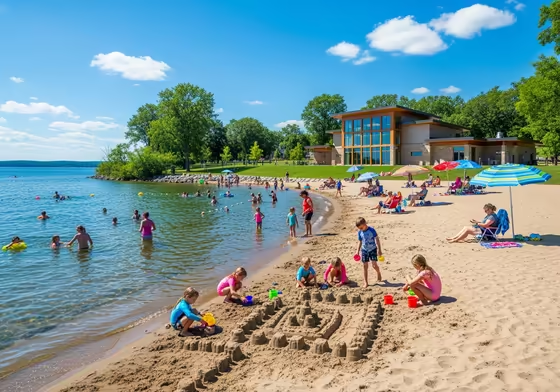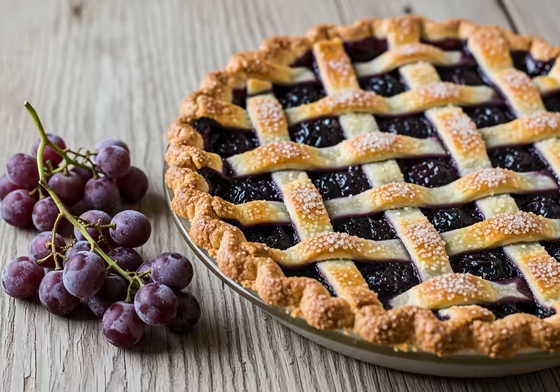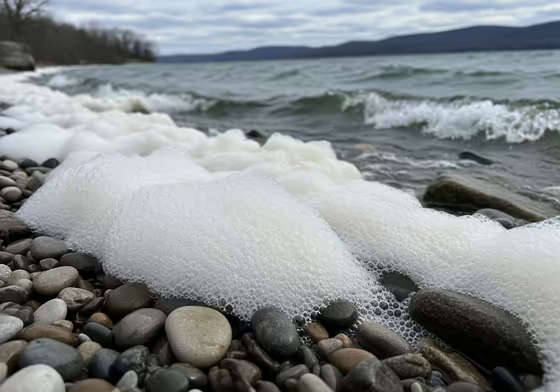Your Guide to Canandaigua Lake
Welcome to Canandaigua Lake
Canandaigua Lake is one of New York's 11 Finger Lakes. It is the fourth largest in the group. The lake is known for having some of the cleanest water in the state.

The shoreline is also lined with expensive homes. This gives the lake a unique feel. It's a mix of protected nature and a high-end destination.
The name Canandaigua comes from the Seneca word Kanandague . This translates to "The Chosen Place." The Seneca people have a story that their tribe began on a hill at the lake's southern end.
Today, the lake provides drinking water for about 70,000 people. Rules are in place to keep the water clean. For visitors, this means you get to enjoy both nature and nice amenities.
The Lake's Key Facts
Canandaigua Lake is long, narrow, and very deep. These features were carved by glaciers long ago. They shape the lake's environment and the activities you can do here.
| Canandaigua Lake: Key Facts | Statistic |
|---|---|
| Length | 15.5 miles |
| Maximum Width | 1.5 miles |
| Average Width | 1.1 miles |
| Maximum Depth | 276 feet |
| Average Depth | 127 feet |
| Shoreline Length | 36 miles |
| Surface Elevation | 688 feet |
| Water Volume | 433 billion gallons |
| Retention Time | 13.4 years |
The lake holds 433 billion gallons of water. A single drop of water stays in the lake for over 13 years on average. This helps keep the water clear, but it also makes the lake sensitive to pollution.
What Makes Canandaigua Special
A few things make Canandaigua Lake different from the other Finger Lakes.
- Clean, Award-Winning Water: The lake is known for its super clean water. It's rated "AA," which is safe for drinking and swimming. The water has even won awards for being the best drinking water in New York.
- A Rare Island: Canandaigua Lake has one of only two islands in all of the Finger Lakes. It's named Skenoh Island. The island is home to rare limestone balls known locally as "water biscuits."
- A Private Shoreline: About 97% of the shoreline is private property . This means there isn't a lot of public access to the water. The few public parks and boat launches are very important for visitors.
Things to Do at Canandaigua Lake
The experience at Canandaigua Lake is all about its clean water, good food, and the two towns at each end.
Having Fun on the Water
Swimming
Since most of the shore is private, there are only a few public beaches. Kershaw Park is the main spot for swimming. It's a large park at the north end of the lake in the City of Canandaigua.

Kershaw Park has a big sandy beach, a bathhouse, and playgrounds. The water is clear and safe for swimming. You can also swim at smaller parks like Onanda Park and Deep Run Park.
The water temperature changes with the seasons. It can be very cold in late May, around 58 to 60°F. By July, it warms up to a nice 70°F and can get close to 80°F in late summer.
Boating and Paddling
The lake's long shape makes it great for motorboats, sailboats, and kayaks. The main challenge for visitors is finding a place to put a boat in the water.
Here are the public boat launches:
- Canandaigua Lake State Marine Park: This is the main launch for trailered boats at the north end. It has ramps and lots of parking, but there is a fee.
- Onanda Park: This park on the west side has a ramp but does not allow trailered boats. It's a good spot for kayaks and canoes, and there's a launch fee.
- Woodville Boat Launch: This launch is at the south end and is run by the state. It has ramps and parking, and it's free to use.
- West River: Also at the south end, this free site works for both small boats and trailered boats.
If you don't have your own boat, several marinas offer services. You can rent kayaks and stand-up paddleboards at places near the north end. Some hotels also offer private boat access for their guests.
Ride the Canandaigua Lady
The most famous boat on the lake is the Canandaigua Lady . It's a replica of a 19th-century double-decker steamboat. It carries on a tradition of passenger boats that were on the lake in the 1800s.

The boat runs from May through October. It offers sightseeing tours, lunch cruises, and sunset dinner cruises. It's a great way to see the lake no matter the weather.
Fishing on Canandaigua Lake
Canandaigua Lake is a top spot for fishing. It's known as a "two-story" fishery. This means it has both cold-water fish like trout in the deep parts and warm-water fish like bass in the shallow areas.

The lake is most famous for its trout. Some are stocked by the state, but the water is clean enough for wild trout to live here too.
- Lake Trout: This is the main cold-water game fish, and its population is kept up by annual stocking.
- Brown Trout: This type of trout is also stocked by the state.
- Rainbow Trout: The rainbow trout here are completely wild. They are not stocked and reproduce naturally in streams that feed the lake, like Naples Creek.
The lake also has great fishing for warm-water fish. You can catch largemouth and smallmouth bass. Other common fish include chain pickerel, yellow perch, bluegill, and rock bass.
How to Catch Big Fish
Many anglers come to Canandaigua hoping to catch a trophy-sized fish.
- What is the biggest fish in Canandaigua Lake? The lake is known for its huge trout. A lake trout weighing over 29 pounds was caught during a fishing derby here.
-
What are the best months for lake trout fishing?
You can catch lake trout all year, but your methods will change with the seasons.
- Spring: Trout follow baitfish into warmer, shallow water, so trolling near the surface works well.
- Late Summer / Early Fall: Jigging is a great technique when lake trout gather in water that is 70 to 80 feet deep.
- Winter: Ice fishing is a popular way to catch lake trout once the lake freezes over.
For real-time tips and charter info, you can check local resources like the Finger Lakes Angling Zone or Omnia Fishing. They provide current reports from other anglers on the water.
Food and Drinks Around the Lake
The area around Canandaigua Lake has a great food scene. You can find everything from wineries and breweries to bakeries and cooking schools.
The Canandaigua Lake Wine Trail
The Canandaigua Lake Wine Trail is a small but good 30-mile trail. It goes from the town of Victor, through Canandaigua, and down the west side of the lake to Naples.

- Heron Hill Tasting Room: This tasting room is in a beautiful 100-year-old barn. It has amazing views of the lake and serves a variety of wines.
- Inspire Moore Winery: This smaller winery in Naples focuses on earth-friendly practices. It's well known for its Riesling, which is a classic Finger Lakes wine.
The trail also includes breweries, distilleries, and cider spots like Star Cider.
The New York Kitchen
A major food destination is the New York Kitchen, located in Canandaigua. It's a school and restaurant that focuses completely on food and drinks made in New York.
This center offers several things to do:
- Hands-on Classes: You can take classes on pasta making, baking, or pairing drinks with food.
- A Tasting Room: They showcase 60 different New York wines, 10 seasonal beers and ciders, and spirits made in the state.
- The Restaurant: A restaurant and bar with great lake views and a menu full of New York products.
Naples: The Grape Pie Capital
The Village of Naples, at the south end of the lake, has a special food tradition: the grape pie . It was created in the 1950s by a local resident named Irene Bouchard .

Grape pies are made from the sweet Concord grapes that grow well in the area. The pie is the main attraction at the Naples Grape Festival. The festival happens every year on the last weekend of September.
Parks and Hiking Trails
The steep hills around the lake offer amazing views and great hiking.
Lakeside Parks
The public parks are the main way for visitors to get to the lake. Each one has a different feel.
- Kershaw Park (North End): This is the lake's main public area. The 9-acre park has a beach, bathhouse, playground, and walkways. It is the best spot for swimming and picnics.
- Onanda Park (West Side): This park feels more like a rustic retreat. It has a lakeside area with cabins and swimming, and an upland area with 2 miles of hiking trails.
- Canandaigua Lake State Marine Park (North End): This park is mainly a public launch for trailered boats.
Hiking Bare Hill
The most famous viewpoint on the lake is Bare Hill, located on the east side. While there are no official recreation trails, service roads are open for hikers. A 0.9-mile hike on the Upper Trail leads to a spot called "Council Rock."
Driving Around the Lake
Driving the 36-mile loop around the lake is a great way to see the area, especially in the fall.

- How long does it take to drive around Canandaigua Lake? The drive takes about one hour without any stops.
- The Scenic Route: The loop follows NY-364 on the west side and East Lake Road on the east. Many people say the west side of the lake has better views.
-
Key Scenic Viewpoints:
The most amazing views are found at the south end of the lake, near the town of Naples.
- Lake View Point Scenic Overlook: This stop on County Road 12 has a beautiful, wide view of the lake's southern end.
- Carolabarb Park: A bit further south, this park offers great views looking north over the lake.
History and Legends of the Lake
Canandaigua Lake has a rich history. It goes from its sacred Seneca beginnings to its time as a summer spot for the wealthy.

The Seneca and the Legend of Bare Hill
The lake is a very important place for the Seneca people. Their name for themselves means "Great Hill People." This comes from a story that their people were born from the earth on South Hill, at the head of Canandaigua Lake.
This connection is part of the legend of Bare Hill. The story goes like this:
- The Pet: A long time ago, a Seneca boy found a strange two-headed serpent and kept it as a pet.
- The Monster: The serpent grew to a huge size and had a giant appetite. It eventually surrounded the Seneca village on Bare Hill, trapping everyone inside.
- The Hero: A young warrior was told in a dream how to kill the serpent. He shot a magic arrow into its heart and killed it.
- The Aftermath: As the serpent died, it thrashed around and scraped all the trees off the hillside. As it rolled into the lake, it coughed up the skulls of the people it had eaten.
This legend is more than just a story. It was an early way to explain the unique features of the lake.
- It explains the bare spot on the hill.
- It explains why the lake is so deep, saying the monster still rests at the bottom.
- It explains the rare "water biscuits," saying they are the round skulls the serpent coughed up.
This history is still honored today. Each year, a bonfire is lit at Council Rock on Bare Hill to kick off the "Ring of Fire" lake celebration.
History of Canandaigua City
The City of Canandaigua became an important town after European settlement. It was the site of the 1794 Treaty of Canandaigua between the U.S. and the Iroquois Confederacy. In 1872, the courthouse hosted the trial of Susan B. Anthony for the crime of voting .
In the late 1800s, the lake attracted wealthy families. Two historic landmarks from that time are now open to visitors.
- Sonnenberg Gardens & Mansion State Historic Park: This is a 50-acre estate with a 40-room Victorian mansion and beautiful gardens. It is open from May to October and has an admission fee.
- Granger Homestead and Carriage Museum: This is a restored 1816 mansion. The main attraction is its collection of over 100 horse-drawn carriages.
Nature at the Lake
The lake's environment is a careful balance between clean water and the threat of invasive species.
Wildlife and Water Quality
People often ask which Finger Lake is the cleanest. While nearby Skaneateles Lake is often called the cleanest, Canandaigua's water quality is excellent. It has a state "AA" rating and has won awards for being the best drinking water.
This clean water supports a lot of wildlife.
- Fish: The lake is home to many kinds of trout, bass, perch, and other fish.
- Birds: The lake is a very important place for birds, especially in winter. It provides a home for large numbers of ducks.
- Invasive Species: The lake's ecosystem is under threat from invasive species. These include zebra and quagga mussels, Asian clams, and plants like Eurasian water milfoil.
What's the White Foam on the Lake?
On windy days, visitors often see white foam along the shore and worry about it. For the most part, this foam is natural and harmless. It is not soap or pollution.

The foam is created when wind and waves stir up natural compounds in the water. These compounds trap air and create bubbles. It's similar to how beating an egg white creates foam.
But there is more to the story. The foam is also a sign of the lake's two biggest environmental challenges.
- The compounds that cause the foam come from a type of algae. This is the same algae that causes harmful algal blooms in late summer.
- The problem gets worse because of invasive zebra and quagga mussels. When the mussels eat the algae, they release more of the foam-making compounds back into the water.
So, while the foam won't hurt you, it is a warning sign. It shows the ongoing battle between algae and invasive mussels in the lake.
Planning Your Trip
A good trip to Canandaigua Lake starts with understanding its layout. The two towns at either end are key to planning your visit.
Getting There and Getting Around
Canandaigua Lake is easy to get to. It is only about 30 to 35 minutes from Rochester. It's about 1.5 hours from Buffalo and 1 hour from Syracuse.
You can find good maps of the area from the Canandaigua Lake Wine Trail or local tourism groups. Getting around is simple, as the main roads form a loop around the lake.
The Two Main Towns
The lake is framed by two towns with very different personalities. It's helpful to plan your trip around what each one offers.
City of Canandaigua (North End)
This is the lake's main town and business center. It's a historic city with a nice, walkable waterfront. Most of the shops, restaurants, and hotels are here.

Canandaigua is the home base for many attractions. Kershaw Park, the Canandaigua Lady cruises, and the New York Kitchen are all in or near the city.
Village of Naples (South End)
This is the lake's quiet, country village. Known as the "grape pie capital of the world," Naples is the center of the area's scenery and farming traditions. It's a small village with art galleries, wineries, and the yearly Naples Grape Festival.
A good plan is to stay in Canandaigua for its hotels and restaurants. Then, take a day trip to explore the wineries, views, and bakeries in and around Naples.
Where to Stay
Your choice of where to stay is important because it decides how you'll get to the lake. This is because 97% of the shoreline is private.
You have two main options:
- Off-Lake Lodging: This includes many good hotels, inns, and bed & breakfasts in the area. If you stay at one of these places, you will use the public parks and boat launches to get to the water.
- On-Lake Lodging: This option gives you private lake access. This includes lakefront resorts like The Lake House on Canandaigua, which has its own docks. It also includes private vacation homes that you can rent.
This choice between using the public 3% or staying at the private 97% is a key part of planning a trip to "The Chosen Place."